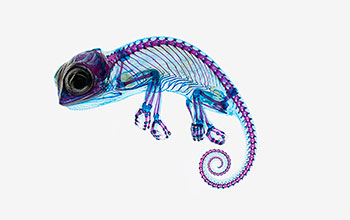Multimedia Gallery
"Alcian and alizarin chameleon"
"Alcian and alizarin chameleon," by Elizabeth Marchiondo, photographer.
Photographer Elizabeth Marchiondo doesn't often have the opportunity to handle organisms as delicate as this chameleon. "I'm used to photographing live aquarium scum through a microscope or wading through a lagoon to capture specimens," she says. So Marchiondo was delighted when zoologist Andrew Gillis donated the deceased creature to Brian Hall's lab at Dalhousie University in Halifax, Nova Scotia, where she was a microscopy intern. Gillis had prepped the chameleon by dipping it in chemicals that rendered its skin and muscles transparent, and then stained its bones and joints with dyes. Because it was a 3-D subject, Marchiondo focused her digital camera on different planes of the chameleon's body and then stitched 32 images together to create a single, crisp picture.
The image won people's choice in the photography category of the 2015 Visualization Challenge, now called The Vizzies, a long-running, annual competition co-sponsored by the National Science Foundation and Popular Science. [The competition was formerly named the International Science & Engineering Visualization Challenge (SciVis) and was previously co-sponsored with AAAS' journal Science.] The competition aims to recognize some of the most beautiful visualizations from the worlds of science and engineering and awards prizes in five categories: photography, video, illustration, posters & graphics and interactives.
To learn more about the competition and view all the winning entries past and present, see the NSF The VIZZIES: Visualization Challenge Special Report. (Date of Image: unknown)
Credit: Elizabeth Marchiondo and Andrew Gillis
See other images like this on your iPhone or iPad download NSF Science Zone on the Apple App Store.
Images and other media in the National Science Foundation Multimedia Gallery are available for use in print and electronic material by NSF employees, members of the media, university staff, teachers and the general public. All media in the gallery are intended for personal, educational and nonprofit/non-commercial use only.
Images credited to the National Science Foundation, a federal agency, are in the public domain. The images were created by employees of the United States Government as part of their official duties or prepared by contractors as "works for hire" for NSF. You may freely use NSF-credited images and, at your discretion, credit NSF with a "Courtesy: National Science Foundation" notation.
Additional information about general usage can be found in Conditions.
Also Available:
Download the high-resolution JPG version of the image. (1.7 MB)
Use your mouse to right-click (Mac users may need to Ctrl-click) the link above and choose the option that will save the file or target to your computer.

